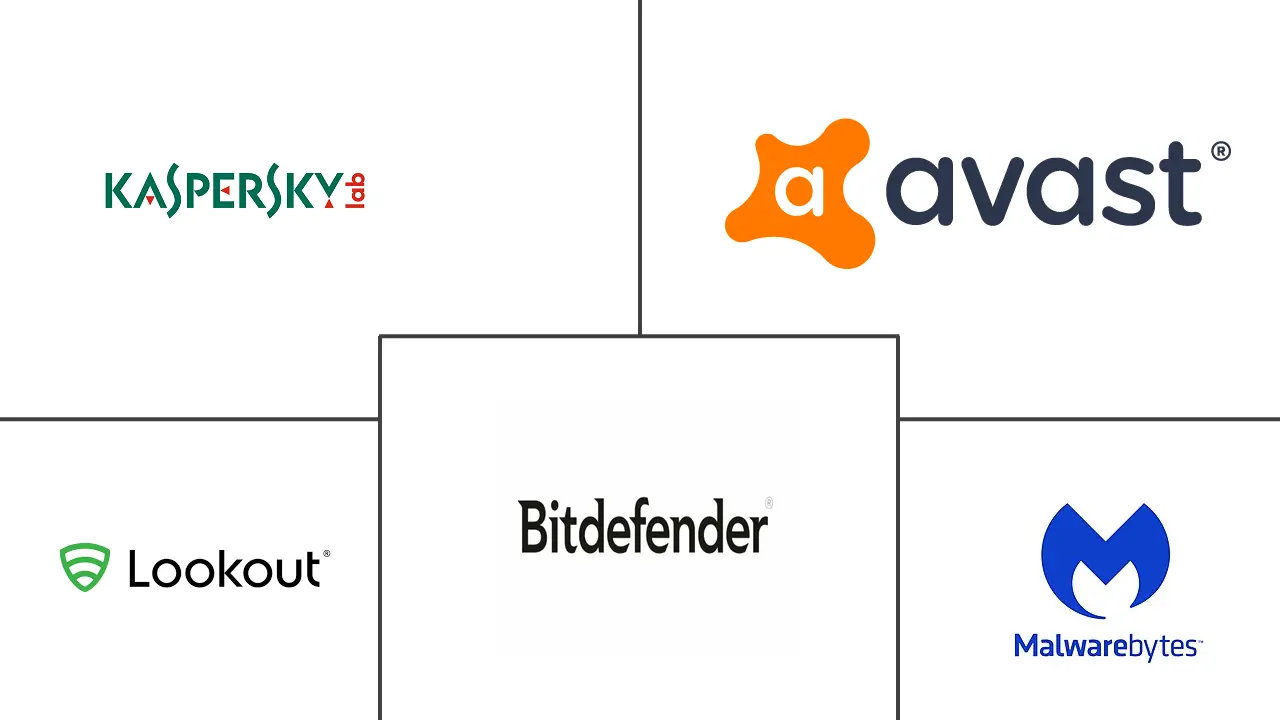Mobile Anti-Malware Market Size and Share

Mobile Anti-Malware Market Analysis by Mordor Intelligence
The mobile anti-malware market size stands at USD 13.93 billion in 2025 and is projected to reach USD 27.42 billion by 2030, reflecting a 14.5% CAGR. Rapid enterprise digitization, generative-AI-driven malware creation, and zero-trust mandates have turned mobile endpoints into primary attack surfaces for threat actors. Large organizations now treat mobile security as core infrastructure, investing in behavioral analytics that detect malicious intent rather than relying on legacy signature scans. Cloud-delivered threat intelligence, geopolitical vendor restrictions, and new device-embedded AI chips also influence adoption patterns, giving vendors with strong research pipelines and managed-service offerings a clear advantage in the mobile anti-malware market[1]Verizon Business, “2025 Mobile Security Index,” verizon.com.
Key Report Takeaways
- By operating system, Android led with 60.1% of mobile anti-malware market share in 2024 while iOS is expected to expand at a 15.5% CAGR through 2030.
- By deployment mode, on-premise installations controlled 70.8% of the mobile anti-malware market size in 2024 whereas cloud platforms are set to grow at 16.2% CAGR to 2030.
- By solution type, integrated endpoint-protection suites commanded 56.2% revenue share in 2024 and security-as-a-service is projected to increase at 15.1% CAGR through 2030.
- By end user, enterprise customers held 67.5% of the mobile anti-malware market share in 2024; the same segment is forecast to post the fastest 15.9% CAGR through 2030.
- By industry vertical, BFSI accounted for 44.3% share of the mobile anti-malware market size in 2024 while healthcare is advancing at a 14.7% CAGR through 2030.
- By geography, North America led with 38.1% revenue share in 2024; Asia-Pacific is poised for the fastest 14.9% CAGR up to 2030.
Global Mobile Anti-Malware Market Trends and Insights
Drivers Impact Analysis
| Driver | (~) % Impact on CAGR Forecast | Geographic Relevance | Impact Timeline |
|---|---|---|---|
| Exploding mobile-specific malware variants post-Generative-AI era | +2.8% | Global, concentrated in North America and EU | Short term (≤ 2 years) |
| BYOD 2.0 and hybrid work driving corporate demand | +3.2% | North America and EU core, expanding to APAC | Medium term (2-4 years) |
| Expansion of mobile payment ecosystems in emerging economies | +2.1% | APAC core, spill-over to MEA and Latin America | Long term (≥ 4 years) |
| Regulatory mandates for zero-trust on employee-owned devices | +2.4% | North America and EU, early adoption in Australia | Medium term (2-4 years) |
| Rise of app-clone supply-chain attacks in third-party Android stores | +1.7% | Global, higher impact in Android-dominant regions | Short term (≤ 2 years) |
| Proliferation of on-device AI security chips enabling real-time scanning | +1.3% | North America and EU initially, expanding globally | Long term (≥ 4 years) |
| Source: Mordor Intelligence | |||
Exploding Mobile-Specific Malware Variants Post-Generative-AI Era
Generative AI tooling now automates the creation of polymorphic code that mutates on each installation, producing 560,000 unique mobile threats every day in 2025. These campaigns blend code obfuscation with GAN-generated phishing screens that mimic trusted apps on both public and private stores. Signature databases can no longer keep pace, prompting vendors to embed device-side machine learning models that score behavior in milliseconds. Providers that combine cloud-scale correlation with on-device heuristics are gaining enterprise preference because they identify intent before execution. This structural shift places continuous R&D and data-engineering capacity at the center of competitive advantage in the mobile anti-malware market.
BYOD 2.0 and Hybrid Work Driving Corporate Demand
Corporate mobility has evolved from convenience to mission-critical access. In 2024, 84% of large North American firms lifted mobile security budgets to secure employee-owned devices that now handle CRM, ERP, and confidential data workflows[2]Verizon Business, “2025 Mobile Security Index,” verizon.com. BYOD 2.0 policies prescribe runtime monitoring of applications, network calls, and hardware state, closing gaps left by conventional MDM tools. Security teams prefer consolidated suites that apply one policy across phones, laptops, and tablets, which strengthens demand for integrated platforms. As a result, premium subscription tiers that bundle threat hunting and automated response drive revenue resilience in the mobile anti-malware market.
Expansion of Mobile Payment Ecosystems in Emerging Economies
Cashless programs in Asia-Pacific generate huge transaction volumes on smartphones, creating direct monetization opportunities for banking trojans and overlay attacks. Financial regulators in India, Indonesia, and the Philippines now require app integrity verification and device attestation before authorizing high-value transfers, turning robust mobile security into a license-to-operate for payment providers. Vendors that integrate anti-fraud telemetry and real-time risk scoring are capturing new projects from banks and fintechs. The same payment-led digitization trend also fuels small-business adoption, enlarging the total addressable mobile anti-malware market in price-sensitive economies.
Regulatory Mandates for Zero-Trust on Employee-Owned Devices
The U.S. Department of Justice introduced data-transfer safeguards in April 2025 that oblige any contractor handling sensitive records to prove continuous device risk evaluation. Canada’s OSFI Guideline B-13 imposes risk-based identity controls in the financial sector, extending zero-trust concepts to all endpoints. Similar directives are under consultation in Germany and Australia. Because penalties for non-compliance include fines and data-access curbs, spending on advanced mobile threat defense remains insulated from budget cycles. Regulatory alignment also simplifies cross-border device administration, encouraging multinational firms to roll out unified cloud consoles for all regions.
Restraints Impact Analysis
| Restraint | (~) % Impact on CAGR Forecast | Geographic Relevance | Impact Timeline |
|---|---|---|---|
| Persistently low consumer willingness to pay for mobile AV | -1.8% | Global, higher impact in price-sensitive markets | Long term (≥ 4 years) |
| OS-level security hardening shrinking threat surface | -1.2% | Global, iOS leading and Android following | Medium term (2-4 years) |
| Geopolitical distrust of foreign cybersecurity vendors | -0.9% | Primarily US and EU, spill-over to allied nations | Short term (≤ 2 years) |
| Privacy-centric OS features reducing AV visibility | -0.7% | iOS-dominant markets initially, expanding to Android | Medium term (2-4 years) |
| Source: Mordor Intelligence | |||
Persistently Low Consumer Willingness to Pay for Mobile AV
Retails users view built-in protections as adequate and often ignore premium tiers that lack visible utility. Conversion rates on freemium apps stay in single digits even during high-profile breach cycles, limiting revenue scalability outside enterprise contracts. Vendors experiment with ad-supported versions, identity-protection bundles, and family plans, yet monetization remains challenging. The gap places a ceiling on consumer revenue, making the enterprise segment pivotal for long-term growth in the mobile anti-malware market.
OS-Level Security Hardening Shrinking Threat Surface
Apple and Google continue to sandbox applications, restrict kernel access, and enforce strict permission regimes. While these improvements raise baseline safety, they also narrow the incremental benefit derived from third-party tools. Providers must therefore showcase value in detecting zero-days, malicious sideloads, or social-engineering exploits rather than general malware. Those that fail to innovate risk commoditization and price erosion.
Segment Analysis
By Operating System: Enterprise Interest Tilts Toward iOS Security Premium
Android retained 60.1% of mobile anti-malware market share in 2024 due in large part to its vast installed base and lower average device cost. At the same time, iOS units are growing at a 15.5% CAGR, supported by hardware attestation and stricter code-signing controls that simplify compliance in regulated sectors. The mobile anti-malware market size for iOS endpoints is projected to almost double by 2030 as hospital groups, insurers, and financial institutions standardize on Apple devices to lower breach-response expenses. Android remains essential in high-growth economies where value phones dominate, so vendors position AI-powered behavioral engines to offset fragmentation and inconsistent patching.
Enterprises increasingly compare total cost of ownership rather than purchase price alone. Security leaders note that fewer critical incidents on iOS translate into lower forensics spending and downtime. However, Android’s open ecosystem spurs innovation in ruggedized devices and specialized toolsets for logistics and field services, ensuring steady demand for next-generation protection agents. Niche operating systems—mainly hardened Linux builds for the defense sector—hold marginal volume yet command high per-seat pricing due to strict accreditation requirements.
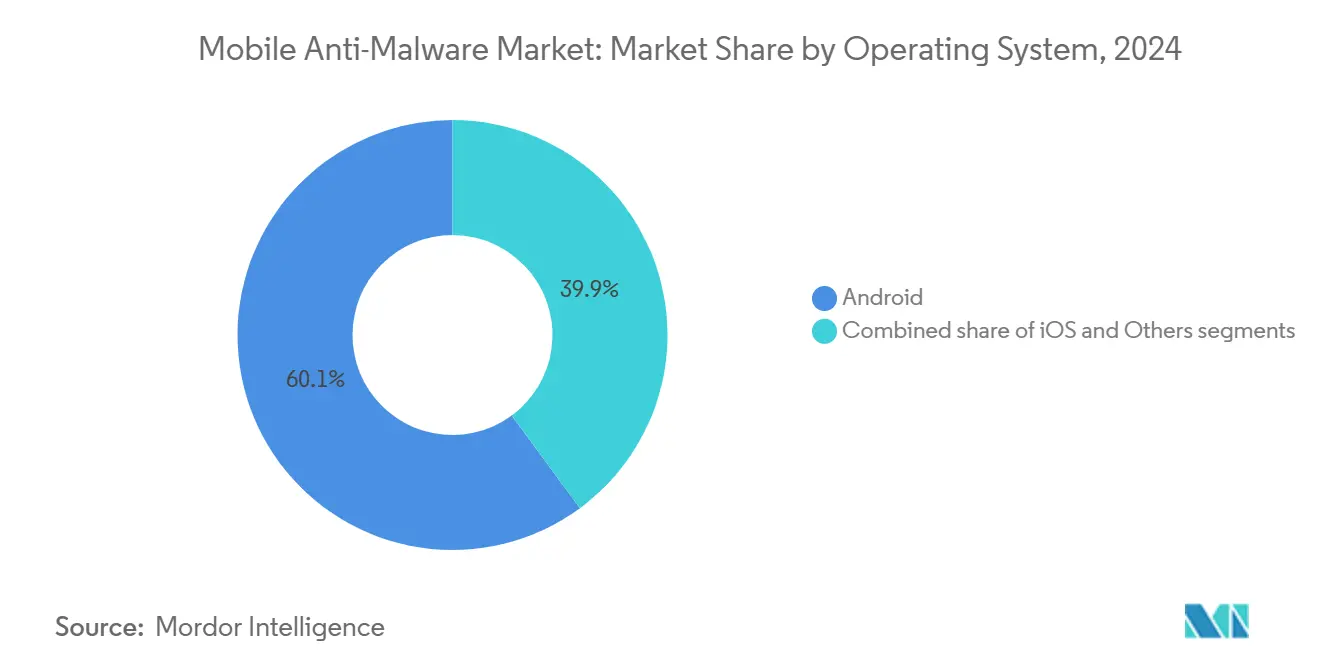
Note: Segment shares of all individual segments available upon report purchase
By Deployment Mode: Cloud Momentum Outpaces Legacy On-Premise
On-premise installations accounted for 70.8% of the mobile anti-malware market size in 2024 because many banks and public agencies still store telemetry inside national borders. Nevertheless, cloud subscriptions are accelerating at 16.2% CAGR as boards approve security-as-operating-expenditure budgets that scale with device counts. Large enterprises cite 40% lower administrative overhead once signature updates, model retraining, and threat-intelligence feeds shift to vendor-managed clouds.
Carrier-grade network connectivity and edge PoPs further reduce latency, making cloud consoles viable for always-on validation even under poor Wi-Fi conditions. Vendors assure compliance via regional datacenters and granular data-retention policies. As a result, hybrid rollouts mixing on-prem for crown-jewel assets with cloud for remote staff are now standard. This transition unlocks incremental revenue because customers expand license volumes rather than perform one-off hardware refreshes.
By Solution Type: Integrated Suites Dominate While SECaaS Scales Fast
Integrated endpoint suites captured 56.2% of 2024 revenue because security teams prefer single-pane management for desktops and phones. Suite vendors embed mobile threat defense, EDR, and identity posture checks into one agent, cutting duplication in policy workflows. That consolidation drives stickiness and higher renewal rates within the mobile anti-malware market.
Security-as-a-service is the fastest-rising offer at 15.1% CAGR, propelled by a global shortage of skilled analysts. Organizations hand off alert triage and proactive hunting to provider SOCs while retaining policy control. Pure-play mobile antivirus apps linger mainly in consumer channels, where lightweight footprints satisfy basic needs. Over the forecast horizon, feature parity between suites and SECaaS will blur, resulting in consumption-based pricing models that combine device and data volume metrics.
By End User: Enterprise Revenues Anchor Long-Term Growth
Enterprise accounts produced 67.5% of revenue in 2024 and are forecast to grow at 15.9% CAGR, ensuring they remain the bedrock of the mobile anti-malware market. These buyers accept multiyear contracts with outcome-based SLAs that penalize vendors for missed detections. They also drive feature roadmaps toward automated remediation, identity correlation, and audit-ready reporting demanded by auditors.
Consumers still represent a sizable installed base but deliver limited ARPU. Many rely on free tiers bundled with VPN or password-manager upsells. Small businesses fall between the two extremes, preferring MSP-delivered mobile security that integrates with broader IT support. The gulf in requirements leads to segmented product lines and divergent marketing channels.
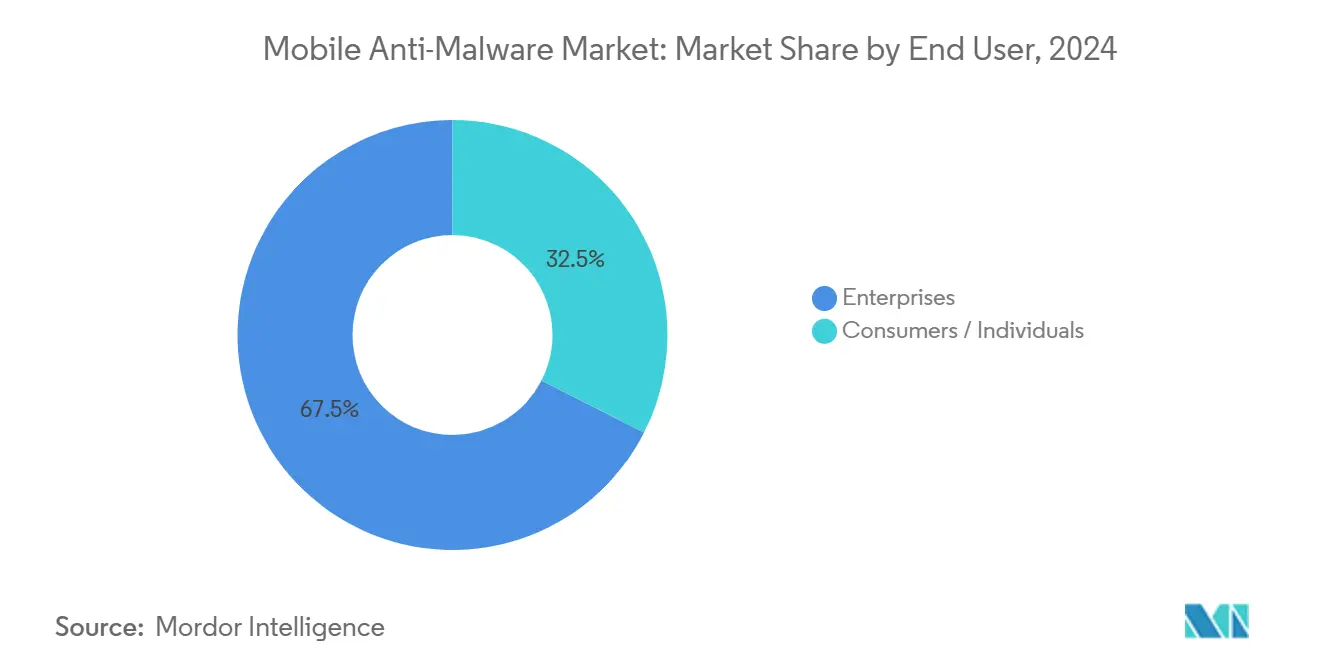
By Industry Vertical: BFSI Leadership Coupled With Healthcare Upside
Banks, insurers, and capital-markets firms controlled 44.3% of mobile anti-malware market size in 2024 as regulators insist on device attestation and secure channels for mobile banking. Attackers target one-time passwords, session tokens, and push-notification gimmicks to drain accounts, so financial institutions invest in telemetry enrichment and behavioral AI.
Healthcare is expanding fastest at 14.7% CAGR because clinicians now use phones for electronic health record access, companion diagnostics, and telehealth. HIPAA and comparable global rules assign heavy fines for data leaks, motivating hospital boards to adopt real-time scanning, jailbreak detection, and remote-wipe functions. Government, telecom, and education sectors comprise the balance, each with unique compliance overlays that shape procurement criteria.
Geography Analysis
North America captured 38.1% of 2024 revenue. This lead stems from large enterprise budgets, established mobility programs, and stringent laws such as the U.S. DOJ data-transfer safeguards that require continuous risk scoring on every endpoint. Canadian banks comply with OSFI-B-13, further cementing demand for certified platforms capable of reporting device posture to regulators. Local vendors also benefit from geopolitical screening that sidelines certain foreign suppliers, reallocating spending toward trusted domestic ecosystems.
Asia-Pacific is the fastest-growing region with a projected 14.9% CAGR to 2030. Cashless commerce, super-app ecosystems, and mobile-first workforces expand the total device pool faster than in mature markets. Enterprises in India, Indonesia, and Vietnam adopt threat-defense agents to satisfy payment-security mandates, while Japanese and Australian organizations upgrade to meet zero-trust guidelines. Regional channel partners bundle managed detection services with connectivity plans, accelerating outreach into mid-market enterprises.
Europe ranks third by revenue, yet remains pivotal because GDPR fines link data breaches to material financial penalties. Multinationals demand local data centers and strict contractual clauses on data export, encouraging vendors to open EU-based threat-intelligence nodes. In Southern Europe and the Middle East, uptake increases as 5G rollouts push mobile workflows deeper into oil, logistics, and smart-city projects. Latin America follows similar patterns, though macroeconomic volatility keeps some deployments in pilot phases rather than full production.
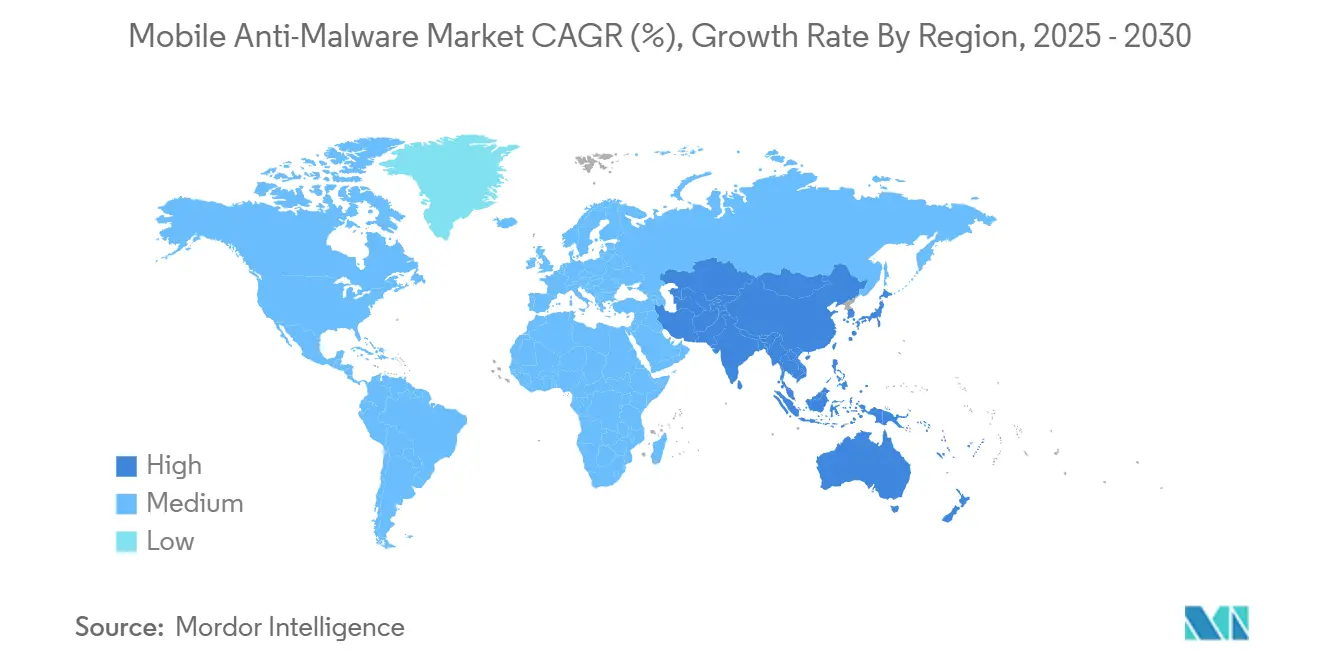
Competitive Landscape
The mobile anti-malware industry displays moderate concentration. Top platforms integrate advanced EDR, cloud analytics, and identity controls, but niche innovators still disrupt with specialized AI models or privacy-preserving architectures. Sophos finalised its USD 859 million Secureworks acquisition in February 2025 to expand managed detection coverage and add XDR telemetry from 500,000 endpoints. CrowdStrike agreed to acquire Adaptive Shield for USD 300 million in November 2024 to weave SaaS posture management into its Falcon platform.
Technology differentiation now revolves around three pillars. First, proprietary data lakes enrich ML algorithms that spot zero-days faster than reliance on public feeds. Second, frictionless deployment via MDM APIs or carrier SIM binding eases large-scale rollouts. Third, ecosystem breadth matters because clients want one console for endpoints, cloud workloads, and identities. Vendors are unable to offer unified telemetry risk marginalisation.
Geopolitics also shapes buying behaviour. The 2024 prohibition on Kaspersky software in the United States redirected government and critical-infrastructure contracts to Western suppliers[3]U.S. Department of Commerce, “Notice of Final Determination on Kaspersky Lab,” commerce.gov. Similar security-of-supply debates influence EU defence procurement. Partnerships between network operators and security firms, such as the 2025 T-Mobile / Palo Alto Networks SASE launch, illustrate convergence between connectivity and protection layers. Emerging vendors focusing on vertical use cases—like medical-device scanning or industrial-control isolation—attract venture capital, signalling continued competitive churn in the mobile anti-malware market.
Mobile Anti-Malware Industry Leaders
-
AO Kaspersky Lab
-
Avast Software SRO
-
BitDefender LLC
-
Lookout Inc.
-
Malwarebytes Inc.
- *Disclaimer: Major Players sorted in no particular order
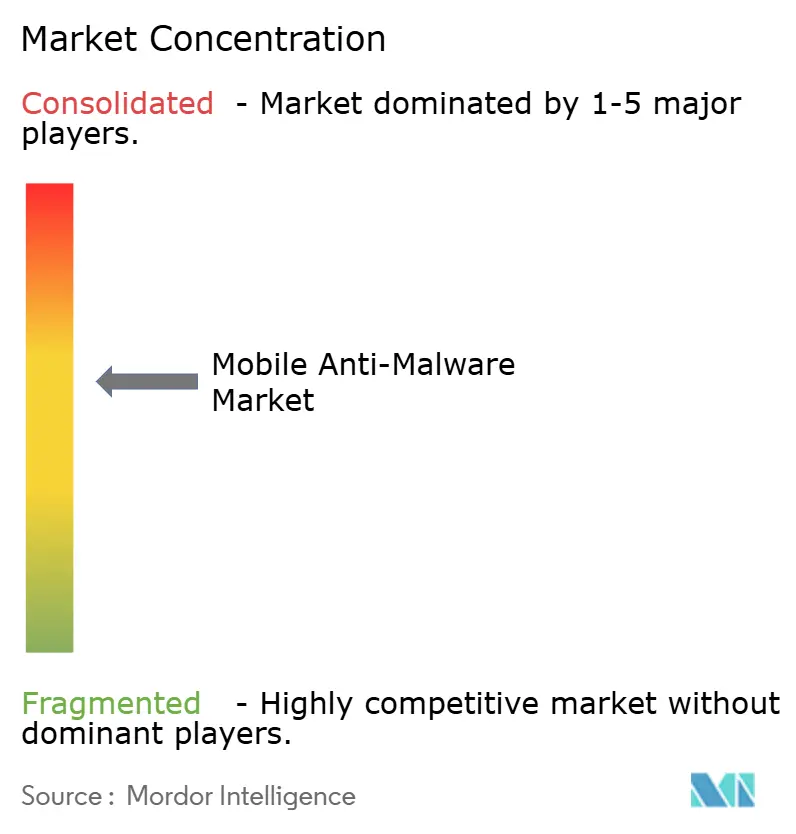
Recent Industry Developments
- June 2025: Malwarebytes launched Scam Guard, an AI-powered companion inside its Mobile Security app that offers real-time scam advice.
- May 2025: T-Mobile and Palo Alto Networks introduced “T-Mobile SASE, with Palo Alto Networks,” combining 5G connectivity with Prisma SASE 5G for enhanced endpoint security.
- May 2025: Fortra acquired Lookout’s cloud security business, adding CASB, ZTNA, and SWG features to its portfolio.
- February 2025: Sophos closed its USD 859 million Secureworks purchase, building a pure-play MDR powerhouse with integrated mobile detection capabilities.
Global Mobile Anti-Malware Market Report Scope
Anti-Malware protects mobile devices from various types of malware, such as adware, spyware, Trojans, and various others. This solution is used on mobile devices such as phones, tablets, and various others. The scope of our study is geographically limited to North America, Europe, Asia Pacific, Latin America, and the Middle East and Africa.
The market sizes and forecasts are provided in terms of value (USD million) for all the above segments.
| Android |
| iOS |
| Others |
| On-premise |
| Cloud |
| Stand-alone Mobile Antivirus Apps |
| Integrated Endpoint-Protection Suites |
| Security-as-a-Service (SECaaS) for Mobile |
| Enterprises |
| Consumers / Individuals |
| BFSI |
| Healthcare |
| IT and Telecom |
| Government and Defense |
| Education |
| Others |
| North America | United States | |
| Canada | ||
| Mexico | ||
| Europe | Germany | |
| United Kingdom | ||
| France | ||
| Italy | ||
| Spain | ||
| Rest of Europe | ||
| Asia-Pacific | China | |
| Japan | ||
| India | ||
| South Korea | ||
| Australia | ||
| Rest of Asia-Pacific | ||
| South America | Brazil | |
| Argentina | ||
| Rest of South America | ||
| Middle East and Africa | Middle East | Saudi Arabia |
| United Arab Emirates | ||
| Turkey | ||
| Rest of Middle East | ||
| Africa | South Africa | |
| Egypt | ||
| Nigeria | ||
| Rest of Africa | ||
| By Operating System | Android | ||
| iOS | |||
| Others | |||
| By Deployment Mode | On-premise | ||
| Cloud | |||
| By Solution Type | Stand-alone Mobile Antivirus Apps | ||
| Integrated Endpoint-Protection Suites | |||
| Security-as-a-Service (SECaaS) for Mobile | |||
| By End User | Enterprises | ||
| Consumers / Individuals | |||
| By Industry Vertical | BFSI | ||
| Healthcare | |||
| IT and Telecom | |||
| Government and Defense | |||
| Education | |||
| Others | |||
| By Geography | North America | United States | |
| Canada | |||
| Mexico | |||
| Europe | Germany | ||
| United Kingdom | |||
| France | |||
| Italy | |||
| Spain | |||
| Rest of Europe | |||
| Asia-Pacific | China | ||
| Japan | |||
| India | |||
| South Korea | |||
| Australia | |||
| Rest of Asia-Pacific | |||
| South America | Brazil | ||
| Argentina | |||
| Rest of South America | |||
| Middle East and Africa | Middle East | Saudi Arabia | |
| United Arab Emirates | |||
| Turkey | |||
| Rest of Middle East | |||
| Africa | South Africa | ||
| Egypt | |||
| Nigeria | |||
| Rest of Africa | |||
Key Questions Answered in the Report
What is the projected value of the mobile anti-malware market by 2030?
The market is forecast to reach USD 27.42 billion by 2030 at a 14.5% CAGR.
Which operating system offers the fastest growth opportunity for vendors?
IOS endpoints are expected to post a 15.5% CAGR through 2030 as enterprises embrace its hardware-rooted security advantages.
Why are cloud deployment models gaining ground over on-premise systems?
Cloud platforms simplify updates, provide scalable machine-learning analytics, and cut administrative overhead by about 40% compared with maintaining local servers.
Which industry vertical spends the most on mobile anti-malware today?
Banking, financial services, and insurance entities hold 44.3% of 2024 revenue due to strict regulatory mandates and the high value of mobile transactions.
How do zero-trust regulations affect market growth?
New laws from the U.S. DOJ and Canadian OSFI require continuous mobile risk evaluation, making advanced threat defense unavoidable for compliant organizations.
What strategic moves are leading vendors making to stay competitive?
Recent acquisitions such as Sophos-Secureworks and CrowdStrike-Adaptive Shield illustrate a shift toward integrating managed detection, identity posture, and SaaS security into unified platforms.
Page last updated on:
